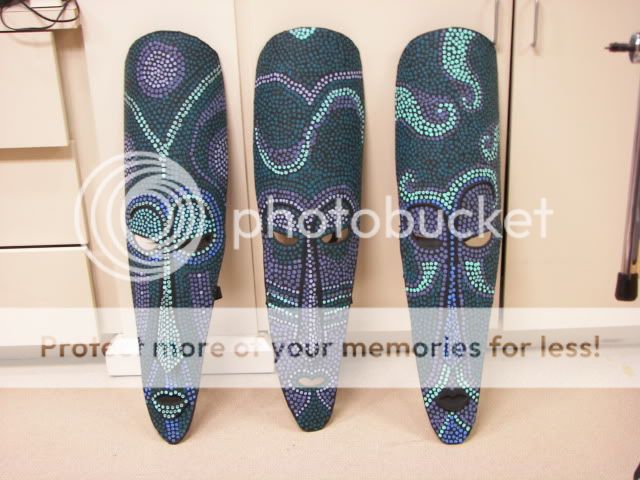In the play, the main character Louis de Rougemont at one point meets an initially-hostile tribe of aborigines. Because all the actors play many roles, they needed to be able to "become" aborigines immediately by taking up some simple prop or costume cue and creating the rest of the character through physicality. We settled on a theatrical version of actual aborigine masks.

An image of several aboriginal masks. I was drawn to the dot-paint technique which connects them to their textile designs as well, as you may recall from the batik mentioned previously.

This is a graphic i made to talk with Tom Quaintance, the director, about the scale of the masks. How big did we want to make them? The actual masks are the scale of option two, and that's how big we decided we should make ours as well.

A maquette made from a cardboard fabric-bolt tube to experiment with shape. I wanted to see whether a cylindric section would work for our basic mask structure, and decided from this maquette that yes, it would.

I scaled it up in oaktag and cut out this mockup, modeled here by second-year graduate student and crafts assistant Samantha Coles Greaves.

Here you see a paint sample on the maquette, next to a section of the actual size oaktag pattern.

First-year grad student and design assistant Adrienne Corral tests paint samples and dot-making techniques on sections of black foamcore. These helped me to decide what types of paints we should use and how we could best make the dot pattern.

We cut the basic mask shapes from a giant cardboard tube product sold for the purposes of making concrete pylons and bollards. These are about $8 each at hardware stores and each one made two mask foundations.

I suspected we might need a wire reinforcement to help with the stability of the lower portion of the mask, where it narrows and will ride at the actors' chest level. I figured that the mask might take some strain there when worn depending on the physical moves of the actors--bending, squatting, etc. Here you see a heavy gauge wire (straightened coathangers, really) ready for securing to the mask's lower edge.

Adrienne sews the wire on with a wide bias casing, much in the same way you might wire the edge of a buckram hat brim. She's using our industrial walking foot machine, though, which can stitch through 1/4" thick cardboard tube, among other things!

Next i added features--a nose from carved styrofoam, narrow cord for eyebrows, and built up the surface over them with layers of papier mache.

Adrienne coats the insides of the masks with layers of Sculpt-or-Coat.

The masks were then painted black with plain black acrylic paint.

What makes the best dots? Q-Tips! Easy, fast, throw them away when you're done. Here i'm painting patterns onto one of the masks.

There they are, three aborigine masks for our show! I love them!
Post by Costume Designer Rachel Pollock
Join us tomorrow for scenes from the rehearsal hall and later in the week... production photos!
